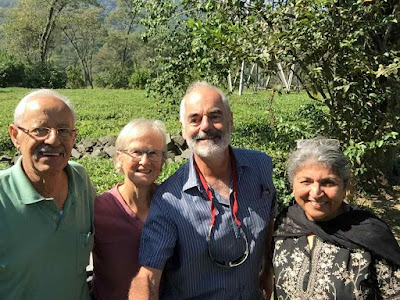Much of the south of England is a mystery to me, so the South Downs Way seemed a good way to see if civilisation had penetrated to Sussex. I got an evening train to Winchester. I also realised that the next day I was
staying in a hostel, which was dry and 2 miles to the nearest pub, and I would have been walking all day in what was forecast to be rain. So nipped to
Sainbsurys and bought a packet of dried pasta, some salad, and multiple ready-mixed gin and
tonics. Felt smugly prepared, but then found I had left my phone charging cable
behind.
Day 1. 19 miles. Winchester to HMS Mercury (abandoned)
Up early, queueing outside the O2 shop to buy a cable, and then set off over the bypass which swept traffic through a huge gash in Twyford Down (remember Swampy and the other tree-dwellers?) Neat, slightly posh countryside, but when I got to the Cheesefoot Head natural amphitheatre I was confronted by a huge metal barrier and watch-posts, like Stalag Luft 11. But it was the Boomtown Music Festival, and as everyone else was arriving to have fun, I had to divert through a huge muddy field.
Up early, queueing outside the O2 shop to buy a cable, and then set off over the bypass which swept traffic through a huge gash in Twyford Down (remember Swampy and the other tree-dwellers?) Neat, slightly posh countryside, but when I got to the Cheesefoot Head natural amphitheatre I was confronted by a huge metal barrier and watch-posts, like Stalag Luft 11. But it was the Boomtown Music Festival, and as everyone else was arriving to have fun, I had to divert through a huge muddy field.
Then, as forecast, it started to really belt down, a serious thunderstorm. Resisting the temptation to gloat over the happy campers, I put on full wet-weather gear and so was fine, except for some anxiety about being struck by lightning. I plodded on looking forward to the
pub at Exton after 12 miles. Then I found it was
essentially a smart restaurant, so as I peeled
off the wet gear and dripped in in my muddy boots, I expected to be immediately thrown out. But they were charming, a welcome pint in an armchair, pork scratchings and soup. Got settled in and didn't want to leave.
 |
| Old Winchester Hill, with beautiful wild-flower planting by National Trust. |
Woke to find thick mist. Briefly had a fine view of the A3, but then the mist
closed in again. Looked forward to breakfast in the cafe in the Queen Elizabeth Countty Park, but it didn't open for another hour. So headed into the forest, and got lost. Spirits dropped. The guide said ‘great views’, but couldn't see a sausage.
 |
| Beacon Hill: 'fine views' are claimed |
I then found I could not charge my phone even with my new cable, so I had no music,
compass, email, watch or camera. Or phone.
Tried to convince myself this was a good thing, as am really too reliant on these things.
Day 3 19 miles, Cocking to Washington
Relieved to find good weather, large
breakfast and set off singing and clicking my stick on the ground in an
irritatingly cheerful manner. Beautiful
day, and the path turned into a classic Way – on a ridge with great views to the sea on the south and the wooded Sussex weald on the north. Fine drop almost to sea-level at
Amberley – again a welcome pub before slogging back up to the standard 200
metre height. I knew I had to get a bus at
the A24 in Washington, and arrived just to see one go. Sat by side of road, with no idea what time it
was, but enjoying watching cars go past. Rather sorry that another bus came along within 10 minutes, but went into Worthing. Worthing has not got a great reputation - someone told me once that they saw a notice in a train toilet saying "Do not flush while in a station", and someone had added underneath "except Worthing". But I had a fine B&B with a sea-view, and found some excellent food. And used a public phone box for the first time in years.
Day 4. 14 miles. Washington to Pyecombe
Amazingly, got bus and met Steve as
arranged at Washington. Very good to
have someone to walk with after 3 days solitary, and we chattered along up to
Chanctonbury Ring, which sounds faintly obscene, but is reputed to be seriously haunted. Some campers had stayed there.
Day 5. XX miles. Pyecombe to Rodmell
Day 6. XX miles. Rodmell to Eastbourne







































